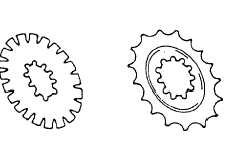portion of the nut. Slots are cut in the outer
portion, forming segments that can be forced
outward when the nut is installed. Elastic
reaction causes the segments to push inward,
gripping the bolt. Like the nylon insert nut, this
nut does not deform the bolt threads and can be
used on frequently removed items. If you can
thread the nut past the deflection segments
without a wrench, discard the nut and replace it
with a new one.
LOCKWASHERS
Many installations on board naval ships still
use lockwashers to prevent threaded fasteners
from loosening. If loosening has not been a
problem, you may replace worn lockwashers with
an identical type; however, if loosening has been
a problem, you should use self-locking fasteners
instead of lockwashers.
The most common lockwasher used is the
helical spring washer. Other types are the conical
and toothed tab.
Helical Spring Lockwashers
The helical spring lockwasher (split ring) (fig.
9-70) is flattened when the bolt is torqued down,
When torqued, it acts as a flat washer contributing
normal friction for locking the screw or bolt and
the working surface; it also maintains the tension
on the bolt. Because of the helical spring
lockwasher’s small diameter, it is usually not
used on soft materials or with oversized or
elongated holes.
Curved or Conical Spring Lockwashers
Curved or conical spring lockwashers have
almost the same properties as the helical spring
lockwasher. They provide a constant tension on
the bolt or screw when loosened. The tension
produced is usually less than that produced by the
helical spring lockwasher. Like any locking device
relying on tension, spring lockwashers may loosen
on shock loading. When the bolt stretches more
Figure 9-70.—Helical spring lockwasher.
Figure 9-71.—Toothed lockwashers.
than the spring distortion from the shock loading,
the washer serves no further purpose. Recheck the
washer, where possible, when shock is sufficient
to suspect loosening. Some spring lockwashers
have teeth on the outer edge. These teeth do not
aid in locking, but they prevent side slippage and
turning.
Toothed Lockwashers
Toothed lockwashers (fig, 9-71) have teeth that
are twisted or bent to prevent loosening. Cutting
edges engage both working surfaces on the nut
and bolt or screw. Some have teeth on the inner
diameter for applications where teeth projecting
beyond the nut are not desired, The most common
type have teeth on the outer diameter. Washers
with teeth on both inside and outside diameters
are used for soft materials and oversize holes.
The teeth are twisted, so as the nut is installed and
torqued down, the rim of the washer supports the
pressure. Any backing off of the nut or bolt
releases tension that allows the teeth to dig into
the working surfaces of the nut and bolt.
INSULATION
The purpose of insulation is to retard the
transfer of heat FROM piping that is hotter than
the surrounding atmosphere or TO piping that
is cooler than the surrounding atmosphere.
Insulation helps to maintain the desired temper-
atures in all systems. In addition, it prevents
sweating of piping that carries cool or cold fluids.
Insulation also serves to protect personnel from
being burned by coming in contact with hot
surfaces. Piping insulation represents the com-
posite piping covering, which consists of the
insulating material, lagging, and fastening. The
INSULATING MATERIAL offers resistance to
the flow of heat; the LAGGING, usually of
painted canvas, is the protective and confining
covering placed over the insulating materials; and
9-47




